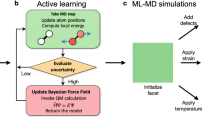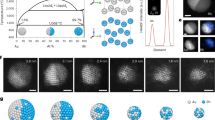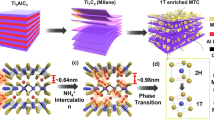Abstract
Metal/two-dimensional substrate composites offer a rich library of materials that can have application in catalysis, sensing, biotechnology and other fields. In situ reduction deposition provides a scalable method for fabricating metal/MXene composites, but the rational control of metal nanostructures growth on MXene remains difficult. Here a strategy for the in situ reduction deposition of various metals (Au, Pd, Ag, Pt, Rh, Ru and Cu) on Ti3C2Tx MXene is demonstrated. This study uncovers the guiding principles of the metal deposition process on MXene nanosheets, including the influence of redox potential, metal coordination and lattice mismatch. A series of metal/MXene composites with fine-tuned structures were constructed based on these guiding principles, such as Pd@Au-Edge/Ti3C2Tx, Pt@Au-Edge/Ti3C2Tx, Au@Ag@Au-Surface/Ti3C2Tx and Ag@Pd@Au-Edge/Ti3C2Tx. In addition, the in situ reduction strategy can be extended to other MXene materials, such as Mo2CTx, V2CTx, Ti3CNTx, Nb4C3Tx and Mo2TiC2Tx, which allows the creation of metal/MXene composites with versatile and customizable nanostructures for a wide range of applications.

This is a preview of subscription content, access via your institution
Access options
Subscribe to this journal
Receive 12 digital issues and online access to articles
$119.00 per year
only $9.92 per issue
Buy this article
- Purchase on SpringerLink
- Instant access to full article PDF
Prices may be subject to local taxes which are calculated during checkout





Similar content being viewed by others
Data availability
Data supporting the findings of this study are available in the article and its Supplementary Information. Source data are provided with this paper.
References
Dai, Y. et al. Broadband plasmon-enhanced four-wave mixing in monolayer MoS2. Nano Lett. 21, 6321–6327 (2021).
Li, Y. et al. Superior plasmonic photodetectors based on Au@MoS2 core–shell heterostructures. ACS Nano 11, 10321–10329 (2017).
Park, C. et al. Confinement of ultrasmall bimetallic nanoparticles in conductive metal–organic frameworks via site-specific nucleation. Adv. Mater. 33, 2101216 (2021).
Cho, C. et al. Strain-resilient electrical functionality in thin-film metal electrodes using two-dimensional interlayers. Nat. Electron. 4, 126–133 (2021).
Zavala, L. A. et al. Direct evidence of the role of Co or Pt, Co single-atom promoters on the performance of MoS2 nanoclusters for the hydrogen evolution reaction. ACS Catal. 13, 1221–1229 (2023).
Shi, Z., Ge, Y., Yun, Q. & Zhang, H. Two-dimensional nanomaterial-templated composites. Acc. Chem. Res. 55, 3581–3593 (2022).
Sun, Y. et al. Interface-mediated noble metal deposition on transition metal dichalcogenide nanostructures. Nat. Chem. 12, 284–293 (2020).
Li, Z. et al. Reactive metal–support interactions at moderate temperature in two-dimensional niobium-carbide-supported platinum catalysts. Nat. Catal. 1, 349–355 (2018).
Wang, M. et al. Site-specified two-dimensional heterojunction of Pt nanoparticles/metal–organic frameworks for enhanced hydrogen evolution. J. Am. Chem. Soc. 143, 16512–16518 (2021).
Wei, Z. et al. Tripodal Pd metallenes mediated by Nb2C MXenes for boosting alkynes semihydrogenation. Nat. Commun. 14, 661 (2023).
Feng, R. et al. Epitaxial ultrathin Pt atomic layers on CrN nanoparticle catalysts. Adv. Mater. 36, 2309251 (2024).
Tan, J., Li, S., Liu, B. & Cheng, H.-M. Structure, preparation, and applications of 2D material-based metal-semiconductor heterostructures. Small Struct. 2, 2000093 (2021).
Sun, Y. et al. Enhancing hydrogen evolution reaction activity of palladium catalyst by immobilization on MXene nanosheets. ACS Nano 18, 6243–6255 (2024).
Li, X. et al. Controllable sulfurization of MXenes to in-plane multi-heterostructures for efficient sulfur redox kinetics. Adv. Energy Mater. 14, 2303389 (2024).
Zhao, Y. et al. Engineering strategies and active site identification of MXene-based catalysts for electrochemical conversion reactions. Chem. Soc. Rev. 52, 3215–3264 (2023).
Li, X. et al. MXene chemistry, electrochemistry and energy storage applications. Nat. Rev. Chem. 6, 389–404 (2022).
Dey, A. et al. Doped MXenes—a new paradigm in 2D systems: synthesis, properties and applications. Prog. Mater Sci. 139, 101166 (2023).
VahidMohammadi, A., Rosen, J. & Gogotsi, Y. The world of two-dimensional carbides and nitrides (MXenes). Science 372, 1581 (2021).
Lim, K. R. G. et al. Fundamentals of MXene synthesis. Nat. Syn. 1, 601–614 (2022).
Sikdar, A. et al. Hierarchically porous 3D freestanding holey-MXene framework via mild oxidation of self-assembled MXene hydrogel for ultrafast pseudocapacitive energy storage. ACS Nano 18, 3707–3719 (2024).
Lan, L., Jiang, C., Yao, Y., Ping, J. & Ying, Y. A stretchable and conductive fiber for multifunctional sensing and energy harvesting. Nano Energy 84, 105954 (2021).
Xi, X. et al. Preparation of Au/Pt/Ti3C2Cl2 nanoflakes with self-reducing method for colorimetric detection of glutathione and intracellular sensing of hydrogen peroxide. Carbon 197, 476–484 (2022).
Zhu, J. et al. Ultrahigh stable methanol oxidation enabled by a high hydroxyl concentration on Pt clusters/MXene interfaces. J. Am. Chem. Soc. 144, 15529–15538 (2022).
Park, S. et al. Reducing the high hydrogen binding strength of vanadium carbide MXene with atomic Pt confinement for high activity toward HER. Appl. Catal. B 304, 120989 (2022).
Zhang, J. et al. Single platinum atoms immobilized on an MXene as an efficient catalyst for the hydrogen evolution reaction. Nat. Catal. 1, 985–992 (2018).
Li, Z., Huang, W., Liu, J., Lv, K. & Li, Q. Embedding CdS@Au into ultrathin Ti3–xC2Ty to build dual schottky barriers for photocatalytic H2 production. ACS Catal. 11, 8510–8520 (2021).
Zhao, D. et al. MXene (Ti3C2) vacancy-confined single-atom catalyst for efficient functionalization of CO2. J. Am. Chem. Soc. 141, 4086–4093 (2019).
Peng, W. et al. Spontaneous atomic ruthenium doping in Mo2CTx MXene defects enhances electrocatalytic activity for the nitrogen reduction reaction. Adv. Energy Mater. 10, e2001364 (2020).
Satheeshkumar, E. et al. One-step solution processing of Ag, Au and Pd@MXene hybrids for SERS. Sci. Rep. 6, 32049 (2016).
Pandey, R. P. et al. Ultrahigh-flux and fouling-resistant membrane based on layered silver/MXene(Ti3C2Tx) nanosheets. J. Mater. Chem. A 6, 3522–3533 (2018).
Zhou, S. et al. Vacancy-rich MXene-immobilized Ni single atoms as a high-performance electrocatalyst for the hydrazine oxidation reaction. Adv. Mater. 34, e2204388 (2022).
Xin, W. et al. Lightweight and flexible MXene/CNF/silver composite membranes with a brick-like structure and high-performance electromagnetic-interference shielding. RSC Adv. 9, 29636–29644 (2019).
Ghidiu, M., Lukatskaya, M. R., Zhao, M.-Q., Gogotsi, Y. & Barsoum, M. W. Conductive two-dimensional titanium carbide ‘clay’ with high volumetric capacitance. Nature 516, 78–81 (2014).
Shahzad, F. et al. Electromagnetic interference shielding with 2D transition metal carbides (MXenes). Science 353, 1137–1140 (2016).
Liu, Y.-T. et al. Self-assembly of transition metal oxide nanostructures on MXene nanosheets for fast and stable lithium storage. Adv. Mater. 30, 1707334 (2018).
Zhang, Q. et al. Synergistic photocatalytic-photothermal contribution enhanced by recovered Ag+ ions on MXene membrane for organic pollutant removal. Appl. Catal. B 320, 122009 (2023).
Wang, Y. et al. Titanium carbide MXenes mediated in situ reduction allows label-free and visualized nanoplasmonic sensing of silver ions. Anal. Chem. 92, 4623–4629 (2020).
Natu, V. et al. 2D Ti3C2Tz MXene synthesized by water-free etching of Ti3AlC2 in polar organic solvents. Chem 6, 616–630 (2020).
Song, X. et al. Oligolayered Ti3C2Tx MXene towards high performance lithium/sodium storage. Nano Res. 13, 1659–1667 (2020).
Shekhirev, M. et al. Ultralarge flakes of Ti3C2Tx MXene via soft delamination. ACS Nano 16, 13695–13703 (2022).
Bao, H. et al. Isolated copper single sites for high-performance electroreduction of carbon monoxide to multicarbon products. Nat. Commun. 12, 238 (2021).
Finzel, J. et al. Limits of detection for EXAFS characterization of heterogeneous single-atom catalysts. ACS Catal. 13, 6462–6473 (2023).
Zhang, Q. et al. Synthesis of large-area MXenes with high yields through power-focused delamination utilizing vortex kinetic energy. Adv. Sci. 9, e2202748 (2022).
Soomro, R. A., Zhang, P., Fan, B., Wei, Y. & Xu, B. Progression in the oxidation stability of MXenes. Nanomicro Lett 15, 108 (2023).
Cao, F. et al. Recent advances in oxidation stable chemistry of 2D MXenes. Adv. Mater. 34, 2107554 (2022).
Jiang, B. et al. Surface lattice engineering for fine-tuned spatial configuration of nanocrystals. Nat. Commun. 12, 5661 (2021).
Natu, V., Sokol, M., Verger, L. & Barsoum, M. W. Effect of edge charges on stability and aggregation of Ti3C2Tz MXene colloidal suspensions. J. Phys. Chem. C 122, 27745–27753 (2018).
Natu, V. et al. Edge capping of 2D-MXene sheets with polyanionic salts to mitigate oxidation in aqueous colloidal suspensions. Angew. Chem. Int. Ed. 58, 12655–12660 (2019).
Jung, Y. et al. Nitrogen-doped titanium carbide (Ti3C2Tx) MXene nanosheet stack for long-term stability and efficacy in Au and Ag recovery. Small 19, 2305247 (2023).
Lon, A., Porter, J., Choi, H. C., Ribbe, A. E. & Buriak, J. M. Controlled electroless deposition of noble metal nanoparticle films on germanium surfaces. Nano Lett. 2, 1067–1071 (2002).
Li, Y. et al. A general Lewis acidic etching route for preparing MXenes with enhanced electrochemical performance in non-aqueous electrolyte. Nat. Mater. 19, 894–899 (2020).
Li, T. et al. Fluorine-free synthesis of high-purity Ti3C2Tx (T = OH, O) via alkali treatment. Angew. Chem. Int. Ed. 57, 6115–6119 (2018).
Acknowledgements
Q.Z. acknowledges support from Institute of Inorganic Membrane Science and Engineering (Shandong University of Technology) and Natural Science Foundation in Shandong Province (ZR2023QB007 and ZR2022QB147) and the Youth Innovation Team of Colleges and Universities in Shandong Province (2023KJ147). H.L. acknowledges support from the National Natural Science Foundation of China (52371140, 21972093 and 21974027), Shanghai Frontiers Science Centre of Biomimetic Catalysis and the Shanghai Engineering Research Centre of Green Energy Chemical Engineering. J.-a.W. acknowledges support from the Welch Foundation (F-1841) Texas Advanced Computing Centre and the Perlmutter at the National Energy Scientific Research Center. C. Zhang acknowledges support from the Program for Eastern Young Scholars in Shanghai and Shanghai Class IV Peak Disciplinary Development Program.
Author information
Authors and Affiliations
Contributions
H.L. conceived and supervised the research. Q.Z., Q.Y., C. Zhang and H.L. wrote and revised the paper. Q.Z., Q.Y., Y.F. and C. Zhang designed the experiments. Q.Z., Q.L. and S.X. performed most of the experiments and data analysis. Q.Z., Q.Y., C. Zhang and H.L. discussed and proposed the mechanism. J.-a.W. and Q.L. performed the theoretical calculations. Q.Z., J.-a.W., Q.Y., Q.L., R.F., C.L., Y.F., C. Zhao, W.C., P.J., J.S., C. Zhang, S.X., G.H. and H.L. participated in experiments and discusions. All authors discussed the results and commented on the paper.
Corresponding author
Ethics declarations
Competing interests
The authors declare no competing interests.
Peer review
Peer review information
Nature Synthesis thanks Khaled A. Mahmoud and the other, anonymous, reviewer(s) for their contribution to the peer review of this work. Primary Handling Editor: Alexandra Groves, in collaboration with the Nature Synthesis team.
Additional information
Publisher’s note Springer Nature remains neutral with regard to jurisdictional claims in published maps and institutional affiliations.
Supplementary information
Supplementary Information
Supplementary experimental details, Discussion, Figs. 1–81, Tables 1–12 and References.
Source data
Source Data Fig. 1
Source data for Fig. 1.
Source Data Fig. 2
Source data for Fig. 2.
Source Data Fig. 3
Source data for Fig. 3.
Source Data Fig. 4
Source data for Fig. 4.
Rights and permissions
Springer Nature or its licensor (e.g. a society or other partner) holds exclusive rights to this article under a publishing agreement with the author(s) or other rightsholder(s); author self-archiving of the accepted manuscript version of this article is solely governed by the terms of such publishing agreement and applicable law.
About this article
Cite this article
Zhang, Q., Wang, Ja., Yu, Q. et al. Metal/MXene composites via in situ reduction. Nat. Synth 4, 252–261 (2025). https://doi.org/10.1038/s44160-024-00660-z
Received:
Accepted:
Published:
Issue date:
DOI: https://doi.org/10.1038/s44160-024-00660-z
This article is cited by
-
Review: MXenes—properties, synthesis, hydrogen storage, catalytic performance, and future prospects
Journal of Materials Science (2025)
-
Ag/Zn-Ta2C MXene composite as an efficient electrocatalyst for aqueous and non-aqueous CO2 reduction reactions
Advanced Composites and Hybrid Materials (2025)
-
Mixing metals with MXenes
Nature Reviews Chemistry (2024)



